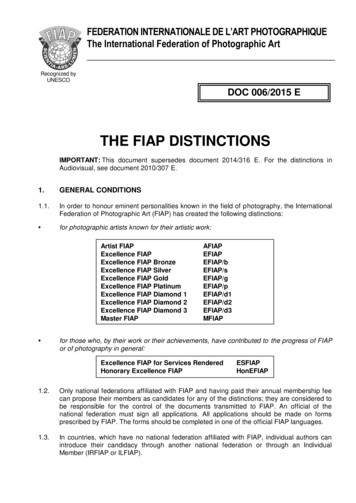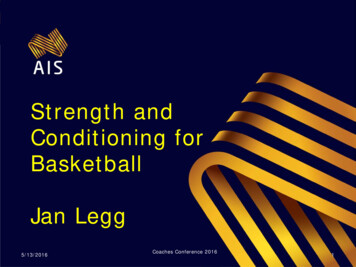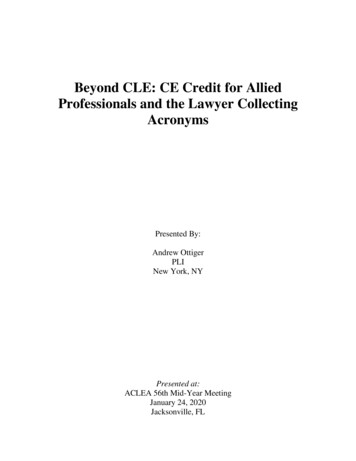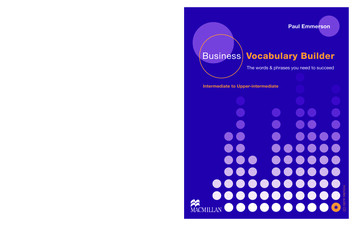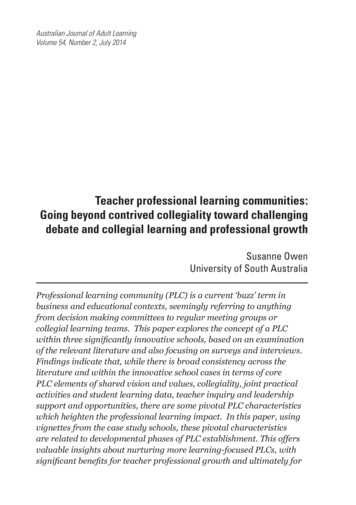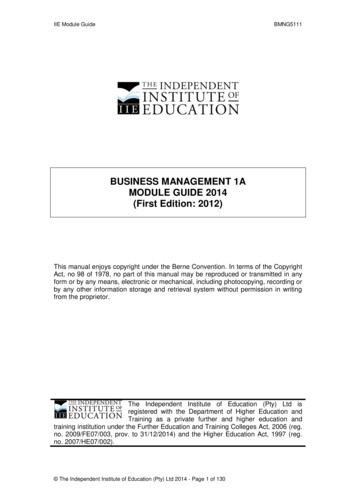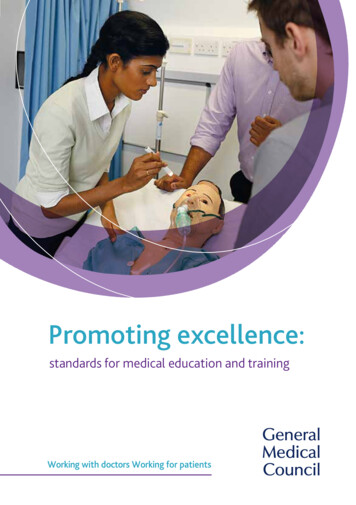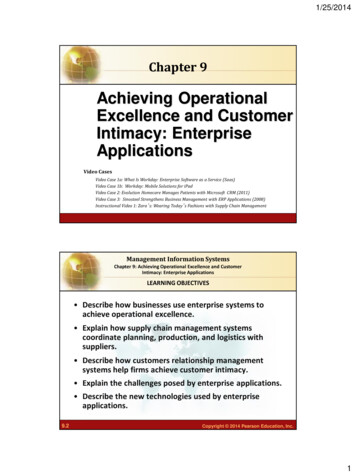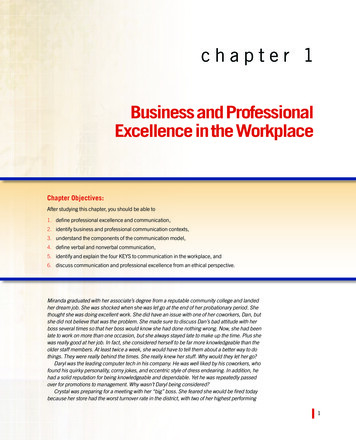
Transcription
chapter 1Business and ProfessionalExcellence in the WorkplaceChapter Objectives:After studying this chapter, you should be able to1. define professional excellence and communication,2. identify business and professional communication contexts,3. understand the components of the communication model,4. define verbal and nonverbal communication,5. identify and explain the four KEYS to communication in the workplace, and6. discuss communication and professional excellence from an ethical perspective.Miranda graduated with her associate’s degree from a reputable community college and landedher dream job. She was shocked when she was let go at the end of her probationary period. Shethought she was doing excellent work. She did have an issue with one of her coworkers, Dan, butshe did not believe that was the problem. She made sure to discuss Dan’s bad attitude with herboss several times so that her boss would know she had done nothing wrong. Now, she had beenlate to work on more than one occasion, but she always stayed late to make up the time. Plus shewas really good at her job. In fact, she considered herself to be far more knowledgeable than theolder staff members. At least twice a week, she would have to tell them about a better way to dothings. They were really behind the times. She really knew her stuff. Why would they let her go?Daryl was the leading computer tech in his company. He was well liked by his coworkers, whofound his quirky personality, corny jokes, and eccentric style of dress endearing. In addition, hehad a solid reputation for being knowledgeable and dependable. Yet he was repeatedly passedover for promotions to management. Why wasn’t Daryl being considered?Crystal was preparing for a meeting with her “big” boss. She feared she would be fired todaybecause her store had the worst turnover rate in the district, with two of her highest performing1
2BUSINESS AND PROFESSIONAL COMMUNICATIONemployees resigning in the past month. She was not sure what was going on. She never had anissue with either one of those employees, unlike a few of her other workers who were her realconcern. These other employees were not pulling their weight. They came to work late, took longlunch breaks, and would leave their stations to take personal calls. To make matters worse, theywere often rude to the other employees as well as to the customers. Crystal had talked to themrepeatedly about changing their ways. She even took them out for lunch every week or so to try toencourage them to perform more professionally. But nothing seemed to work. Why were her bestemployees leaving and her low-performing employees not improving?John gave a big presentation today at work. He had spent hours and hours working on hisPowerPoint slides. They were loaded with information—lots of statistics and charts. In fact,he had more than 50 slides in his 20-minute speech. When he began speaking, he was a littlenervous. Because he had spent most of his time working on the slides, he did not have muchtime to practice. Still, he had the slides to read, and he thought the presentation went well.However, his audience seemed uninterested when he was speaking, and no one approachedhim after the speech to praise him for a job well done. Why didn’t his preparation pay off?Reading these stories may have caused you to stop and think for a moment aboutyour own communication and the role communication can and will play in yoursuccesses and failures in the workplace. You may ask yourself, “Will I be able toget an interview? Will I be considered for a promotion at work? Will I fit in at my new job?What’s the best way to run a meeting? What are the qualities of a professional presentation?How should I respond to negative coworkers?” The preceding questions are commonlyasked by people entering the workplace for the first time, as well as by people changingjob titles, duties, or careers. It seems that regardless of the position or the industry in whichyou desire to work, there is one thing that will make or break the experience: communication. Welcome to the world of business and professional communication. As you studybusiness and professional communication over the course of this semester, we encourageyou, regardless of your major, to take these principles and objectives to heart. After all,communication is the key to professional excellence, and professional excellence is thekey to success.Let us introduce ourselves as your coauthors. We approach this project with years of experience teaching communication courses such as public speaking, business and professionalcommunication, interviewing, teamwork and leadership, organizational communication, andpublic relations. Balanced with our teaching experience and expert knowledge in the communication field are years of professional consulting and real-world experience in a varietyof industries, including retail, manufacturing, shipping, health care, government, education,and more. We know firsthand the communication challenges you will face and the communication skills you will need to succeed. Based on our teaching and professional experience,we wrote this book for you, the student as a developing professional.When designing this text, we talked to professors and students alike, trying to get asense of their needs. Two themes emerged from those conversations. First, instructors andprofessors are frustrated because students do not read their books. As a result, class discussions, exam scores, and student learning suffer. On the flip side, students are frustratedbecause they find most books extremely expensive and full of information they deem asunimportant. Repeatedly, students asked, “Why can’t professors just put the stuff I need toknow on a PowerPoint slide?” Our goal when writing this text is to address both problems/needs. We have tried to develop a text that speaks directly to you as a student who desiressuccess after graduation. We realize that those of you taking this class and reading this
Chapter 1: Business and Professional Excellence in the Workplacetext are interested in different professions and are in different stages of your professionallives. Given the array of professional journeys taking place in the lives of you the readers,we have included topics that will be valuable to everyone. The topic areas of the text willfocus on entering the workplace, developing in the workplace, excelling in the workplace,presenting in the workplace, and surviving in the workplace. We explore the experiencesyou will face as you transition from student to professional, and eventually to leader. Youwill come to understand the role of communication in successfully handling situationssuch as job interviewing, providing feedback to supervisors, and working in teams. As anadditional feature, this text not only discusses the greatest challenges we all will face in themodern workplace, but it also provides communication strategies for overcoming thosechallenges. Issues such as excelling under the pressure of increasingly competitive customer service demands, managing emotions when dealing with irate customers, overcoming stress and burnout, and managing difficult people are just a few of the topics covered.We hope that this approach will engage you as both a student and a reader.Business and Professional Excellence in ContextThe text’s driving theme is professional excellence. To demonstrate excellence as a professional, you must demonstrate excellence as a communicator. Excellence does not equateto merely communicating a message effectively or simply demonstrating communicationcompetencies. Professional excellence means being recognized for your skills as a communicator and serving as a role model to others (see Photo 1.1). Before you begin your journeywith this important topic, it’s important to understand the business and professional contexts that will receive specific attention in this book. The business and professional contextsyou will explore are the job-seeking process,workplace culture and diversity, interpersonal communication, team communication,communication and technology, writtencommunication, leadership, presenting as aprofessional, and work-life balance. Theseare the contexts that will no doubt shapeyour experience as a professional. Keep inmind that communication is at the core ofthe business and professional contexts youwill study in this course. Let’s a take look ateach one in more detail.Landing the JobThe first context you will study in Chapter 2is job seeking. Our approach is to providethe information you’ll need to conduct acomprehensive job search and know yourself in terms of professional goals and thetype of work environment you desire. JobPhoto 1.1 When you hear the word professional, who or whatcomes to mind? This picture illustrates one way professionalsmight look today.3
4BUSINESS AND PROFESSIONAL COMMUNICATIONseeking is one context in which businessand professional excellence is critical toyour success (see Photo 1.2).Getting to Know YourDiverse WorkplaceOnce you’ve landed the job, you’ll entera diverse workplace context. You will nodoubt have coworkers who have viewsof the world and ways of living that aredifferent from yours. Further, it can taketime to learn the organizational culture interms of your role and how you fit in.Photo 1.2 Where would you begin to search for jobs in the industryAs Chapter 3 explores, getting to knowor profession in which you’re interested?the diverse workplace goes beyond newemployee orientation. The diverse workplace context requires professional excellence that’s fostered by careful self-inventory,adjustment, and mutual respect.Interpersonal CommunicationCentral to your personal and professional growth in any career are the relationships and overall rapport you’ll have with your boss, coworkers, and clients. Chapter 4 reviews the importance of interpersonal communication in common business and professional encounters.While interpersonal communication (also referred to as your people skills) helps you buildrelationships in your personal and professional life, it’s critical to be aware of the challengesthat these skills can help you survive (e.g., conflict, difficult coworkers and clients).Team CommunicationAnother common experience for professionals across industries is working in a team context. You’ve probably heard other people use terms such as team player, team skills, andteam building in reference to job performance. Working in a team context can be both arewarding and exhausting experience for any professional. Chapter 5 pays specific attention to the team context that you’ll likely encounter in your professional life, as well asstrategies that foster professional excellence regarding team communication.Communication and TechnologyTechnology in business and professional contexts is central to communication, planning,marketing, networking, organization, research, and the like. Technology allows you to communicate faster than in years past with the use of e-mail, personal digital assistants, and ahost of other devices designed to make the exchange of information in business instant ratherthan delayed. Chapter 6 examines the impact of communication and technology on businessand professional contexts. As technology enables you to excel at work with faster information
Chapter 1: Business and Professional Excellence in the Workplaceexchange and interaction, it’s important to be aware of the problems and misunderstandingsthat can occur when technology serves as your primary means of communication.Written CommunicationChapter 7 examines written communication as it connects to professional excellence. Asyou enter business and professional contexts that require you to use written communication, it is important for you to make decisions that will ensure professional excellence.Written communication can challenge professionals in a variety of contexts. How do Iselect the correct format to get the message out? Is it appropriate for me to send this document via e-mail? What tone should I strive for in this message? These are only a few of thequestions about written communication that you may encounter in your career.LeadershipChapter 8 reviews the role of leadership in business and professional contexts. In orderto excel as a leader, you must understand what leadership is and get to know what styleof leader you are and if your style works best in the business and professional context inwhich you’re working. Further, this chapter explores the challenges leaders experience, aswell as strategies for leading difficult people and managing workplace conflict.PresentationsAs a professional, you will enter situations that require you to give presentations. Thepresentation context arises in many forms (e.g., informative, persuasive, motivational, andteam presentations). Chapters 9, 10, and 11 explore the presentation skills essential toyour professional success. When you’re presented with an opportunity to give a formalpresentation, pitch a product, present research findings, run a meeting, conduct a morning huddle, acknowledge outstanding employees, or motivate your team in difficult times,view that speaking situation as an opportunity to communicate professional excellence.Work-Life BalanceChapter 12 looks at how the variousexperiences in your professional life andpersonal life can be in tension with oneanother. This tension can present quite achallenge, which can lead to stress andburnout (see Photo 1.3). We emphasizethe importance of work-life balance,explore the triggers that cause imbalance,and present communication strategies thatenable you to sustain professional excellence and foster meaningful and successful relationships in your personal life.Present in each of these contexts isthe KEYS process.Photo 1.3 As much as anyone wants to be successful professionally,it’s important to think about personal and family life, too.5
6BUSINESS AND PROFESSIONAL COMMUNICATIONKEYS for Workplace ExcellenceYou will learn to demonstrate professional excellence by using KEYS, a communicationprocess designed to enhance your ability to critically assess and then improve your communication skills. By following the KEYS process, you will learn to utilize your communication strengths and develop your weaknesses, deliver audience-centered messages,understand the communication context, and reflect on your communication with the intention and ability to continually improve.Effective business and professional communication is central to your success whenentering the workplace for the first time, developing your skills at a job you already have,excelling in your career, or managing challenges that may come your way. But you may bewondering, “How can I master this multifaceted, multidimensional skill? How can I makesense of all this information and really make it useful in my career so that I get somethingpractical out of it, something that can enhance my business and professional communication skills and improve my life?” The “how” you are looking for is available to you in thiscourse. Studying communication will enhance your skills as a professional. Doing wellin this course will afford you the tools needed for professional excellence. Furthermore,making the KEYS process a part of your communication interactions will continue yourdevelopment long after this course ends.What is the KEYS process? The KEYS process (see Figure 1.1) is central to your development as a professional, meaning that we encourage you to personalize it as you continueto expand your understanding of business and professional communication. KEYS is anacronym for Know yourself, Evaluate the professional context, Your communication interaction occurs, and Step back and reflect.K—Know yourself: means to actively assess our skills as communicators and thendevelop strategies to utilize our strengths and develop our weaknesses. Accordingly, inthe style of the Greek aphorism “Know thyself,” we assert that truly competent communicators are concerned with identifying their weaknesses in order to work on improvingthem.E—Evaluate the professional context: entails proactively addressing the needs ofour audience and understanding the constraints of the communication situation, as wellas developing our skills for communicating with a variety of audiences across situations.Y—Your communication interaction: requires us to monitor our own verbal and nonverbal cues in addition to the cues of the audience within each communication interaction.S—Step back and reflect: encourages us to examine the effectiveness of verbal andnonverbal messages we convey to others and the overall success of various communication interactions and then take what we’ve learned and start the process again, developing the ability to continually adapt and improve.The organizing feature of this text is the KEYS process, a process designed to developcritical thinking skills and make you more reflexive communicators with the ability toadapt and continually improve. What we strive for in this book is a balance of theory andpractice—an approach that emphasizes skill development based on knowledge and understanding. Review Figure 1.1 to familiarize yourself with the KEYS process. We will use this
Chapter 1: Business and Professional Excellence in the WorkplaceFigure 1.1 KEYS to Communication in the WorkplaceKnow yourself: challenging people to actively assess their skills as communicators andthen develop strategies to utilize their strengths and develop their weaknessesEvaluate the professional context: teaching people to proactively address the needs of theiraudience and understand the constraints of the professional communication context, as wellas developing their skills for communicating with a variety of audiences and contextsYour communication interaction: asking people to monitor their own verbal and nonverbalcues in addition to the cues of the audience within each communication interactionStep back and reflect: examining the effectiveness of verbal and nonverbal messageswe convey to others and the overall success of various communication interactions andthen taking what we’ve learned and starting the process again; developing the ability tocontinually adapt and improvefeature to personally engage, prepare, and improve human communication in the variety ofsituations we all have or will encounter in our lives as professionals, regardless of industry.Defining CommunicationAs you begin your study, it’s important to define what communication means. Communication has been defined in many ways, but here’s the definition we prefer: Humancommunication is the process of understanding our experiences and the experiences ofothers through the use of verbal and nonverbal messages (Beebe, Beebe, & Ivy, 2007; Ivy& Wahl, 2009). People come to understand that communication in everyday experiences isthe essential process and skill that helps them make sense of things in both personal andprofessional contexts.Even if you have some reservations about your communication skills, you probablyconsider yourself to be a good communicator and good listener. Most people do. After all,it’s difficult to admit being bad at something you do all day, every day for your entire life.Because communication is so much a part of our everyday lives, we think of communication as a simple process. Communicating comes so naturally to us that we rarely feel theneed to give communication a second thought. When was the last time you really stoppedand examined your communication skills? Do you stop and examine your communicationregularly? Most people don’t.In some cases, people who fail to reflect on their communication skills trudge throughlife thinking that they are great communicators when they are in actuality dreadful communicators. They exemplify a behavior called communication bravado—perceiving theircommunication as effective, while those around them perceive it as ineffective (Quintanilla &Mallard, 2008). Ineffective communicators view communication as simply talking—but trulyeffective communicators know it is far more complicated than that.Do you take your communication skills for granted? Are you suffering from com munication bravado? Let us assure you that you do indeed have some weaknesses in7
8BUSINESS AND PROFESSIONAL COMMUNICATIONyour communication and listening, simply because everyone does. However, understanding why communication is important and how the communication process worksis the first step in overcoming those weaknesses and starting on the road to professionalexcellence.The Importance of CommunicationRegardless of your major or the career path you eventually follow, effective communication will be essential to your success in the workplace. Your fellow students understandthe value and importance of communication in their careers. Of 116 students surveyedat a southwestern university, 97% agreed that communication is a valuable skill and 88%see themselves using oral presentation skills in their careers (Mallard & Quintanilla, 2007).Further support for the importance of communication in your professional careers comesfrom business and industry focus groups. In 2008, the U.S. Department of Labor reviewedthe results and presented a list of important job skills and communication competencies.Take a moment to review Table 1.1, in which we’ve summarized the competencies. You’llTable 1.1 Communication Competencies List (U.S. Department of Labor/Business and Industry)PersonalEffectivenessCompetencies Teamwork Must be able to work as a team member Play well with others Respect others in the workplaceCommunication General SkillsDesired byEmployers Phone interviews—exhibiting personality and people skillsPersonal appearance—professionalismMust come to work and be on timeOne-on-one people skills—social skills must be sharpSensitivity to diversity in the workplaceMust pass criminal background checkIntegrity is criticalAvoids inappropriate phone calls/text messages at workDevelop and deliver presentations using appropriate mediaConduct meetingsInterpret nonverbal behaviors to enhance communicationUsing politically correct/appropriate languageShare information effectively, small group communicationBe able to deal with the publicDo not use text messaging–type abbreviations in e-mailsand conversation Phone-answering skillsProblem-solving skillsWriting skillsBeing willing to work your way to the topCommunication skills
Chapter 1: Business and Professional Excellence in the Workplacenotice that all the competencies listed in the table are connected to your study of businessand professional communication in this course.Communication: A Complex ProcessCommunication is a complex process (see Figure 1.2). You see that the communicationprocess consists of a number of elements, all of which are in play every time you communicate. Those who demonstrate professional excellence consider these elements everytime they communicate. By the end of this semester, so will you. Let’s examine each ofthese elements in more detail.Sender and ReceiverWe stated above that, practically speaking, communication involves sending and receivingmessages; so it should be no surprise that you take on the roles of sender and receiverwhen you communicate. When you are acting as the sender, you encode your messageswith verbal and nonverbal cues to help others understand what you mean. When thereceivers of your messages respond or decode your message, you find out if your message was successfully transferred. In one sense, this exchange of message and responseis a cocreation of meaning, in that both parties play a role in cocreating a meaningfulFigure 1.2 Communication ModelHow Communication NoiseContextSOURCE: Model is adapted from Lucas (2007).RECEIVER/SENDER9
10BUSINESS AND PROFESSIONAL COMMUNICATIONPhoto 1.4 Professionals send and receive verbal and nonverbal messages in a variety of contexts.exchange. While the person initiating the exchange (the sender) can’t control how thelistener (or receiver) interprets the message, the goal is for the listener to understand themeaning of the message as the sender intended it.The respective roles of sender and receiver in communication seem fairly clear-cut, but intruth, communication is experienced in a more holistic manner—not as senders and receivers but as communicators. Consider an example: You run into a friend, Pat, while walkingto class. Pat says, “Hey, how’s it going?” You return the greeting and begin to tell Pat aboutyour plans for the weekend (you are attending a cousin’s wedding). At some point during the story you are telling (how your cousin met her fiancé), you notice Pat checkinghis wristwatch. You cut off your story and say goodbye, and each of you walks to class. Inone view of this example, you and Pat switch off as senders and receivers: Pat sends youa greeting, which you receive; you send Pat an explanation of your weekend plans and astory, which Pat receives; then Pat sends you a nonverbal cue that time is short, which youreceive by ending the encounter. In another view of this example, you and Pat are bothcommunicators, as you simultaneously send and receive messages (see Photo 1.4).Message and FeedbackImplicit in the preceding discussion of senders and receivers is that a message is communicated. One principle from the field of communication suggests you cannot notcommunicate.
Chapter 1: Business and Professional Excellence in the WorkplaceTo say that you cannot not communicate is not to say that everything is communication. Rather, it means that messages have both a verbal and nonverbal component. In theprevious example, Pat did not say anything verbally, but he did send a message nonverbally when he checked his watch. What was his message? That is not clear. He may havebeen giving a nonverbal cue that your wedding story was too long. He may have hadan appointment and he needed to be on his way. Only Pat knows for sure. The point is,regardless of whether he intended to provide a message, Pat did and you responded inaccordance with the meaning you took from that message.Also included in the communication model is feedback. In the model, you will see thatfeedback is sent from the receiver to the sender. However, since the distinction betweensender and receiver is in many ways arbitrary, feedback is the same as the message. Ascommunicators, the notion of feedback reminds us to look for cues from the other personor persons with whom we are communicating.ChannelThe channel is simply the method by which you send your message. With all the technology available today, deciding which channel to use can be a daunting task. When youadvance in your career and move into a leadership position, you’ll have to evaluate themerits of various communication channels daily. Given the message, should you meet withmembers of your team one-on-one or call a meeting? Is it better to send a memo or ane-mail? Should you call or should you text? Each communication channel brings with it avariety of strengths and weaknesses that will be discussed in a later chapter.ContextAlways and everywhere, communication is contextual. Context refers to the location, time,and occasion where communication occurs. Developing professional excellence meansbeginning to assess your communication context and use that information when developingyour message. For instance, consider the context of the business and professional communication course. Virtually everyone in the course is there because they have to be. As a result,if you give a speech in this course, your audience may not be interested or knowledgeableabout the topic you select; you might need to educate them and take conscious steps tocapture their interest. However, if you are giving a speech to a group of employees abouttheir cost of living and merit raises, they will be hanging on your every word.NoiseNoise is part of the communication context. Noise can be either external or internal. External noise includes distractions such as audible talking during a meeting, ruffling of papers,or a cell phone going off in the next cubicle. For our purposes, the definition of externalnoise is extended to include any external factor that could interfere with a communicator’sability to focus on the message. In a meeting, external noise might also include a teammember sending text messages with the sound on or whispering while your boss is talking.Internal noise encompasses any internal condition or state that interferes with thecommunicator’s ability to focus on the message. If your meeting starts at 11:00 a.m.,your team members may be looking forward to lunch; if you hold an emergency meeting at 6:00 a.m., your team may be tired. Being tired or hungry creates internal noise.As a listenerwith professionalexcellence, you mustwork to overcomeboth internal andexternal noise.11
12BUSINESS AND PROFESSIONAL COMMUNICATIONDeveloping professional excellence includes learning to consider things such as contextand noise when making decisions about your communication interactions. Rememberthat both internal and external noise are more than just preventing you from focusingon the message. That is, both types of noise can also interfere with your understandingof the message. You can be focused on a message and still not understand.Principles of CommunicationDuring our discussion of message, we touched on the components of verbal and nonverbal communication. Given the essential role each plays in effective communication andprofessional excellence, it’s important to discuss them each in more detail.Verbal CommunicationWhat is verbal communication? Verbal communication is both our words and our verbalfillers (e.g., um, like). Verbal messages are created through language. Effective communication involves accurate interpretations of others’ verbal messages as mea
Business and Professional Excellence in the Workplace. c h a p t e r 1. Chapter Objectives: After studying this chapter, you should be able to 1. efine professional excellence and communication,d 2. dentify business and professional communication contexts,i 3. nderstand the components of the communi
